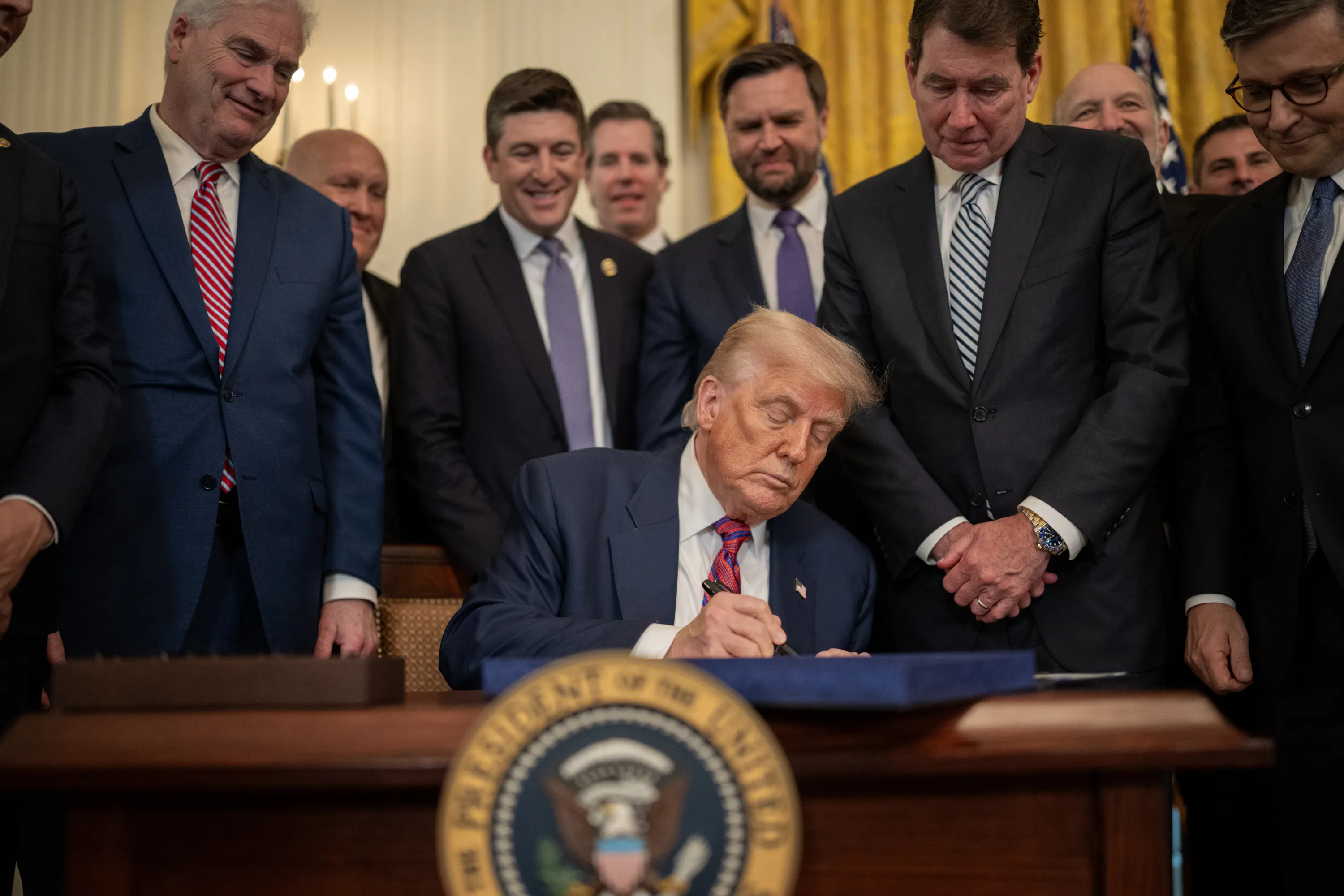This is the impact of global firms on trade

Events of the last year have raised questions about the future growth of international trade.
Image: REUTERS/Aly Song
Andrew B. Bernard
Jack Byrne Professor of International Economics, Tuck School of Business, Dartmouth CollegeJ. Bradford Jensen
Professor of Economics and International Business, McDonough School of Business, Georgetown UniversityStephen Redding
Harold T. Shapiro Professor in Economics, Economics Department and Woodrow Wilson School, Princeton UniversityStay up to date:
Trade and Investment
Modern international trade increasingly takes place in complex cross-border global value chains (Johnson and Noguera 2012, Amador and di Mauro 2015). Even as global production has grown more complex, events of the last year have raised questions about the future growth of international trade. In Europe, the Brexit vote threatens to roll back decades of closer regional integration. In the recent US presidential campaign, Donald Trump threatened higher tariffs on Chinese imports, and has indicated that one of his first priorities in office is to pull out of the Trans-Pacific Partnership (TPP).
Missing from the policy debate is the extent to which international trade is dominated by ‘global firms’ that both import and export and are likely to be part of multinationals.1 The top 1% of US trading firms (around 2,000 firms) account for over 80% of total US trade. Of these largest US exporters, 90% also import goods and account for around 66% of US goods imports. These global firms employed 13.8 million workers in 2007, around as many as the entire US manufacturing workforce. This pervasiveness of global firms has important implications for trade and trade policy. Policies to restrict imports such as tariffs are sometimes suggested as a means of protecting a nation’s firms. However, if the most productive and largest firms export and import worldwide, such policies can have the unintended consequence of hurting rather than helping the most successful firms.
In recent work, we examine the role played by such global firms in the international economy (Bernard et al. 2016). We develop a new theoretical framework that incorporates a wider range of margins of participation in the international economy than previous research. Each firm can choose production locations in which to operate plants; export markets for each plant; products to export from each plant to each market; exports of each product from each plant to each market; the countries from which to source intermediate inputs for each plant; and imports of each intermediate input from each source country by each plant. Firms that participate so extensively in the international economy are unlikely to be too small to affect aggregate outcomes and indeed account for substantial shares of observed trade. Therefore, we allow these global firms to internalise the effects of their pricing and product introduction decisions on market aggregates.
We organise our empirical work around four sets of theoretical predictions.
- First, firm decisions for each margin of participation in the international economy are interdependent.
Importing decisions are interdependent across countries because the decision to incur the fixed costs of sourcing inputs from one country gives access to lower-cost suppliers, which in turn reduces firm production costs and prices. These lower prices imply a larger scale of operation, making it profitable to incur the fixed costs of sourcing inputs from other countries (as in Antràs et al. 2014). Exporting and importing decisions are also interdependent. Incurring the fixed exporting cost for an additional market increases firm revenue, making it profitable to incur the fixed cost of sourcing inputs from any given country. This interaction between exporting and importing in turn implies that exporting decisions are interdependent across markets.
- Second, firm decisions along multiple margins of international participation magnify the effects of differences in firm productivity on endogenous outcomes, such as sales and employment.
More productive firms participate more intensively in the world economy along each margin. Small differences in firm productivity can have magnified consequences for firm sales and employment.
- Third, these global firms are large and their choices can affect market aggregates, giving rise to strategic market power (Atkinson and Burstein 2008, Hottman et al. 2016).
Firms with larger market shares face lower perceived elasticities of demand leading them to charge higher markups of price over marginal cost. This provides an explanation for empirical findings of ‘pricing to market’, where firms charge different prices in different markets. Variable markups also are compatible with ‘incomplete pass-through’, whereby cost shocks are not passed through fully into consumer prices (e.g. De Loecker and Goldberg 2014).
- Fourth, the magnification of exogenous differences across firms implies that aggregate trade is concentrated in the hands of a relatively small number of firms (see also Freund and Pierola 2015).
Hence our framework offers new insights for understanding the skewed distribution of sales across firms (e.g. Sutton 1997, Axtell 2001).
In Figures 1 and 2, we illustrate the interdependence of these margins and the concentration of trade across firms.2 In the main panel, we report means across decile bins of total firm trade. In the call-out panel, we show means across percentile bins of the top decile of total firm trade.
Figure 1 Value of firm exports, imports and total trade by decile/percentile of firm total trade

Figure 2 Value of firm related-party trade by decile/percentile of firm total trade

The main panel of Figure 1 shows that the logs of the average values of firm exports and imports increase monotonically across the first nine deciles of the firm total trade distribution. Total trade for the average firm increases roughly 225% from one decile to the next. The picture changes drastically for the top decile. Average total trade for the largest ten percent of firms is 42 times greater than that of the previous decile. The biggest traders are far larger than the rest of the trading firms and this pattern holds for both their imports as well as their exports. The distribution of trade across firms has a fractal property where the same pattern holds across percentiles of the top decile as across the deciles of the distribution as a whole. Average total trade, exports, and imports increased relatively steadily until the very top percentile when it jumps again. The top 1% of traders are 15 times larger than the second largest percentile of firms.
In Figure 2, we calculate the average value of related-party trade, trade within multinationals.3 Average related-party trade is sharply increasing across the deciles. The most global firms not only import and export more overall, but also import and export more with related parties. Related-party exports and imports are more concentrated in the largest firms, so that related-party trade accounts for a bigger share of overall trade for these most global firms. The average firm in the top percentile of trading firms conducts 29 times as much related-party trade as the average firm in the next percentile.
In a world of interdependent firm decisions, small reductions in tariffs or trade costs can have magnified effects on trade flows, as they induce firms to serve more markets with more products at greater volumes and at the same time source greater volumes of intermediate inputs from more countries. Understanding the effects of changes in trade barriers on one margin (e.g. imports) requires taking into account its effects on other margins (e.g. exports), as firms change the organisation of global production chains. Policies to restrict imports, can end up hurting the most successful producers, for whom both importing and exporting are a central pillar of their overall business strategy.
References
Amador, J and F di Mauro (2015), The Age of Global Value Chains: Maps and Policy Issues, CEPR Press.
Antràs, P, T Fort, and F Tintelnot (2014) “The Margins of Global Sourcing: Theory and Evidence from US Firms,” Harvard University, mimeograph.
Atkeson, A and A Burstein (2008) “Pricing to Market, Trade Costs and International Relative Prices,” American Economic Review, 98, 1998-2031.
Axtell, R (2001) “Zipf Distribution of US Firm Sizes,” Science, 293, 1818–1820.
Bernard, A B, J B Jensen, S J Redding and P K Schott (2016) “Global Firms,” Journal of Economic Literature, forthcoming, and CEPR Discussion Paper, 11555.
Blanchard, E J, C P Bown, and R C Johnson (2016) “Global Supply Chains and Trade Policy” NBER Working Paper 21883, January.
De Loecker, J and P Goldberg (2014) “Firm Performance in a Global Market,” Annual Review of Economics, 6, 201-227.
Freund, C, and M D Pierola (2015) “Export Superstars,” Review of Economics and Statistics, 97(5), 1023-1032.
Hottman, C, S J Redding and D E Weinstein (2016) “Quantifying the Sources of Firm Heterogeneity,” Quarterly Journal of Economics, 131(3), 1291–1364.
Johnson, R P and G Noguera (2012) “How much value added is traded?” VoxEU.org, 2 July.
Sutton, J (1997) “Gibrat’s Legacy,” Journal of Economic Literature, 35(1), 40–59.
Endnotes
[1] Blanchard et al. (2016) provide evidence that discretionary US tariff policy reflects the importance of global value chains.
[2] The horizontal axis of the graph in the lower left of each figure represents the ten deciles of firms sorted by their total trade (imports plus exports) and is held constant across each of the figures. The horizontal axis of the graph in the upper right hand corner of each figure covers firms in the 90th to 100th percentiles of the firm total trade distribution and is held constant across the figures. The vertical axes in the figures use a log scale.
[3] Related-party trade refers to trade between US companies and their foreign subsidiaries as well as trade between US subsidiaries of foreign companies and their foreign parents.
Don't miss any update on this topic
Create a free account and access your personalized content collection with our latest publications and analyses.
License and Republishing
World Economic Forum articles may be republished in accordance with the Creative Commons Attribution-NonCommercial-NoDerivatives 4.0 International Public License, and in accordance with our Terms of Use.
The views expressed in this article are those of the author alone and not the World Economic Forum.
Related topics:
Forum Stories newsletter
Bringing you weekly curated insights and analysis on the global issues that matter.
More on Economic GrowthSee all
Agshin Amirov and Azar Hazizade
September 19, 2025
Muhammad Osama Khan and James Balzer
September 18, 2025
Eric White and Elia Tziambazis
September 18, 2025
Lars Holmquist
September 17, 2025
Dante Disparte
September 17, 2025
Hazuki Mori and Luigi Scatteia
September 17, 2025






